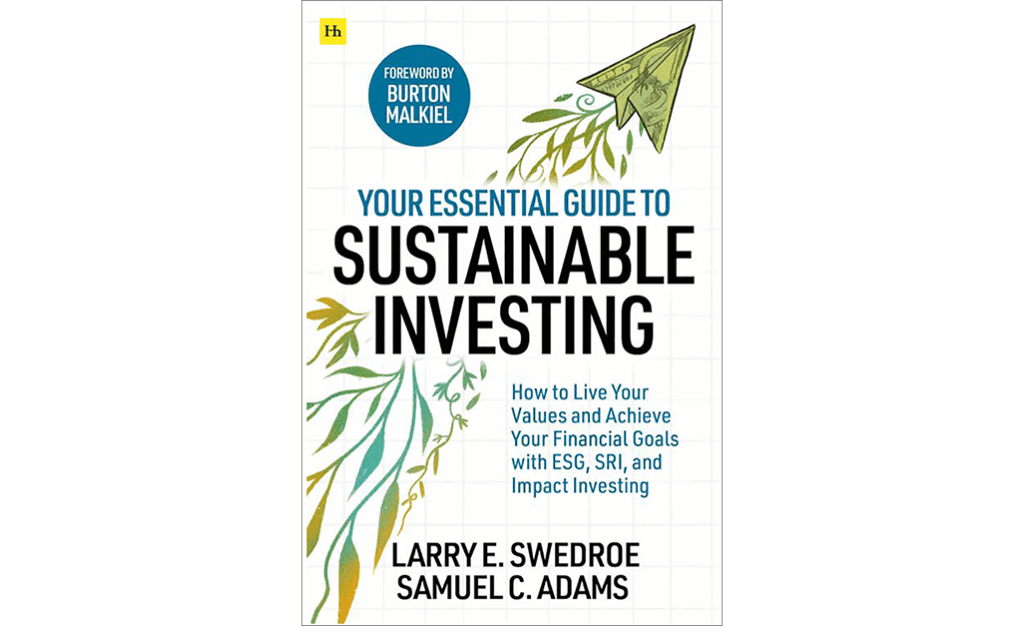ljubaphoto/E+ via Getty Images

Your Essential Guide to Sustainable Investing. 2022. Larry E. Swedroe and Samuel C. Adams. Harriman House.
The establishment of the United Nations-backed Principles for Responsible Investment (PRI) in 2006 marked a turning point for investors. The PRI united signatories under a framework that was consistent with the neoclassical underpinnings of traditional finance — the pursuit of the best risk-adjusted returns — while making explicit how environmental, social, and governance (ESG) issues should be included in the analysis and valuation of securities and in subsequent engagement with management and the voting of proxies. While the practices of responsible investment (RI), socially responsible investment (SRI), and morals-based screening had been long intertwined without clear definition, by implicitly limiting the consideration of ESG issues to those that are financially material to shareholders the PRI set a boundary that in turn helped define the other sustainable finance practices.
For most investors (universal owners such as pension funds may be slightly different) the overlap between RI and SRI ends when shareholder and stakeholder interests are no longer aligned. The primary benefits of the PRI’s framework have been as a catalyst for the incorporation of material ESG issues into investment practices, and as a signpost for the limits to which investors would naturally consider ESG issues. Beyond these limits stakeholders need to seek other avenues for change such as regulatory or legal reform, or changes to consumer behavior. Despite the PRI’s helpful framework, “sustainable investment” has less clarity today. Both media representation and asset manager marketing materials conflate the shareholder and stakeholder approaches with morals-based screening and impact investing, leaving us once again in need of guidance.
Investment professionals and authors Larry Swedroe and Samuel Adams step into this quagmire of mixed messaging with a helpful and timely tome. Their first chapter tackles the central issue head on — “there are dozens of forms of sustainable investing” — and promptly (in the same sentence!) offers a framework that forms the outline for their guide — “we can categorize most of them into three general categories: ESG, SRI, and impact.” The book is well-organized, well-paced, well-articulated, and welcome; a good starting point for those seeking to understand the history and current practices of sustainable investing, and for those seeking practical guidance, including (for US investors) specific investment examples. The book recommendation comes with two important qualifications, however, which are discussed at the end of the review.
First the strengths; Swedroe and Adams cover the “what,” “how,” and “who” of sustainable investing in the book’s first 30 pages. The “what” chapter includes summaries of SRI, impact investing, and ESG investing and includes examples of each strategy — a vegan climate ETF; a farmland REIT; and an ESG-aware ETF — which both professional and retail investors will find helpful. The “how” chapter explains the nuanced differences among:
- Negative/exclusionary screening
- Positive/best-in-class screening
- Norms-based screening
- ESG integration
- Sustainability-themed investing
- Impact/community investing
- Corporate engagement and shareholder action
The “who” chapter covers:
- Sovereign wealth funds
- Pension plans
- College and university endowments
- Faith-based investors
- Family offices and foundations
- Financial advisors and wealth managers
- Individual investors
- Institutional asset managers Investor coalitions (including the PRI).
This chapter provides insight into the methods and challenges of each investor type such as, “Endowments can find it challenging to invest sustainably because of their unique set of stakeholders.”
Following their concise introduction Swedroe and Adams explore in depth “why” investors choose to invest sustainably and “what” they hope to accomplish. They note that sustainable investors “seek to promote a better world, through the societal return achieved by improving outcomes for both people and the planet.” The three returns to sustainable investing — financial, societal, and personal — are reviewed, leaving readers well equipped (after a short chapter that expands on the history of sustainable investing) to consider in depth the performance and impact of sustainable investing. Both chapters are comprehensive — combined, they account for about half of the book’s content — and have a strong academic tilt not present until this point. Investment professionals will find the two chapters particularly helpful, but retail investors may be challenged by the sheer volume of the literature review. It is also in these two chapters that the authors’ use of multiple frameworks (RI and SRI in particular) begins to creak under the strain of shifting perspectives.
Noting that decades of data supported the factor research that refined the capital asset pricing model (CAPM), the authors caution that researchers’ current efforts to identify ESG factors are limited by the short time span of ESG data. They also note a divergence in both ratings and ratings methodologies by the major ESG ratings agencies, and it is here that the creaking is first heard. As with the issuer size and price-to-book ratios used in the original factor research, academics seeking to identify an ESG “factor” rely on standardized inputs for their research, including the ratings from ESG ratings providers. The same ESG ratings also help asset managers develop (and market) their negative or positive screens for investment funds, ratings, and screens that resonate with an investing public to align their moral or social goals with their investment holdings. However the divergence in ratings is much less relevant to active managers who integrate the ESG information into their valuation models. Researchers and investors use ESG ratings for their “headline scores,” while analysts use the 50-plus page reports as an input so that material ESG issues can be incorporated into a security’s valuation. That the utility of ESG ratings is dependent upon an end user’s perspective is emblematic of the current tangle in sustainable finance and highlights the benefit of a consistent framework — ideally the “financial materiality” framework promulgated by the PRI. As founding Sustainalytics CEO Michael Jantzi opined at a responsible investment conference I attended, the marketplace should ultimately determine which rating methodology is preferred by end users.
The authors next review performance implications for ESG factors — sin stocks and screening, carbon intensity and risk, best-in-class — and cover impact, equity, and fixed income investing (including reference to a journal article co-written by long-time Enterprising Investor book review editor Marty Fridson). The literature review extends to the next chapter, which considers the impact resulting from sustainable investment, such as the higher valuation of corporations with superior ESG ratings (notwithstanding the earlier caution on ESG ratings providers). The higher valuations “mean that investors should expect lower future returns over the long term” but (citing a separate study) “by pushing green asset prices up (lowering the cost of capital) and brown ones down (raising the cost of capital), investors’ tastes for green holdings induce more investment by green firms and less investment by brown firms.”
Swedroe and Adams also review the impact on firms’ abilities to raise new capital and the impact on IPO pricing. The authors do cover specific ESG outcomes such as employee satisfaction, improvement in Sustainable Development Goals (SDGs), and impact on environmental and carbon risks, but even here the impacts are primarily relayed in terms of firm valuation rather than actual stakeholder outcomes. Finally, the chapter reviews research that seeks to determine if mutual funds labeled as “sustainable” include companies that meet certain ESG criteria relevant to stakeholders. Further to the comment above about how ESG ratings are used differently by researchers and for the labeling of investment funds on the one hand, and by analysts practicing ESG integration on the other, readers are advised to take note whether the commentary is from an RI (shareholder) or SRI (stakeholder) perspective.
This brings me to the first qualification for Your Essential Guide to Sustainable Investing — one that is common to most guides and most literature on SRI, ESG investing, impact investing, and sustainable finance: the narrative contains internal inconsistencies and/or heuristics that link investor motivation and investment outcomes in ways that do not stand up to scrutiny. Swedroe and Adams begin well with their delineation of ESG, SRI, and impact investing, but the substantive chapters blur their starting definitions/frameworks to leave readers with less clarity than they might have had if the authors had used the PRI’s shareholder-oriented framework throughout. As noted above, this is evident in the characterization of ESG ratings providers as arbiters of companies’ values rather than as informational inputs to their valuation. It is also evident in the similar stakeholder-oriented consideration of mutual funds’ holdings (ESG integration does not inherently produce a tilt to holdings; rather it combines material ESG factors into calculation of all security prices). Even the authors’ comment about endowments’ challenges with sustainable investment shows the elision of valuation and values as it assumes that an SRI approach is preferable and more impactful than an ESG integration plus engagement/proxy voting approach. This is opposite to early results from my own research on institutional investors’ proxy voting.
As a finance professional who works with both retail and institutional clients, I find more helpful a framework that is grounded in the settled theory of neo-classical and behavioral finance. The authors cite Meir Statman’s recent book Finance for Normal People, which explains how neoclassical and behavioral principles combine in our decision making. They helpfully offer an example from Statman in which on Valentine’s Day we give a rose (behavioral) rather than a five-dollar bill (neoclassical), despite the latter’s superior utility. Swedroe and Adams’s book would have been more helpful if — like Statman — they had been more consistent in identifying the underlying frameworks. The authors clearly know their subject well from both a theoretical and practitioner standpoint. They use plain language, provide clear examples, and offer rich discussion but they have missed an opportunity to enhance their guide through use of a framework.
The second qualification for the book is that its content, while excellent, appears to come from two separate authors. The book shifts from targeting a general (retail investor) audience to investment professionals and academics, which may leave both audiences somewhat frustrated. Noteworthy are the appendices, which are both clear and directed at retail as well as institutional investors. The appendices include (even more) history of SRI; advice on how to work with and choose a financial advisor and how to select ESG mutual funds and ETFs; an ESG resource guide; and a fund manager interview guide. Do not let the two qualifications put you off buying this timely guide. It is comprehensive and well written. Retail investors and investment professionals alike will receive plenty of new material to help them find firm ground on the shifting sands of sustainable investment.
Disclaimer: Please note that the content of this site should not be construed as investment advice, nor do the opinions expressed necessarily reflect the views of CFA Institute.
Editor’s Note: The summary bullets for this article were chosen by Seeking Alpha editors.


Be the first to comment